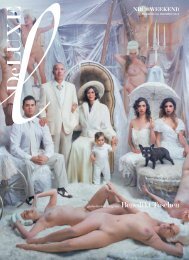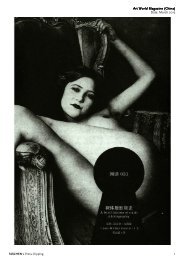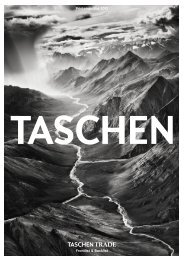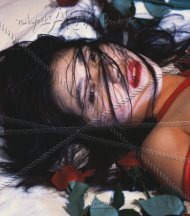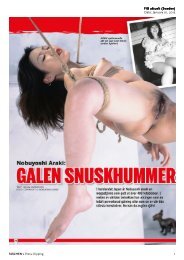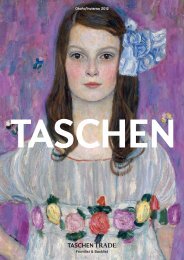STrUCTioN - Taschen
STrUCTioN - Taschen
STrUCTioN - Taschen
Create successful ePaper yourself
Turn your PDF publications into a flip-book with our unique Google optimized e-Paper software.
December 2012<br />
February 2013<br />
Land of expression<br />
Savage caricatures<br />
The earth as canvas<br />
In the mid-60s, artists in the USA and Europe began planning works for sites outside<br />
the narrow boundaries of galleries and museums. It began with ephemeral enhancements<br />
or traces left in desolate landscapes, in the deserts of America, or in the moors<br />
of Scotland. Following this were spectacular earthen sculptures of gigantic proportions,<br />
some of which are still in the process of completion today. One distinguishing<br />
feature of Land Art is its critical preoccupation with the tradition of sculpture.<br />
Sculpture can now be an earthwork excavation, a field of metal poles, a buried hut, a<br />
trace in the grass, or even a book. Another of the movement’s special characteristics is<br />
its emphasis on site-specific, outdoor works intended to lastingly alter our perception<br />
of places, and to set new parameters in art production and reception.<br />
Artists included:<br />
Carl Andre, Alice Aycock, Herbert Bayer, Christo & Jeanne Claude, Walter De<br />
Maria, Agnes Denes, Jan Dibbets, Hamish Fulton, Andy Goldsworthy, Michael<br />
Heizer, Nancy Holt, Peter Hutchinson, Patricia Johanson, Dani Karavan, Richard<br />
Long, Mary Miss, Robert Morris, Dennis Oppenheim, Charles Ross, Robert<br />
Smithson, Alan Sonfist, James Turrell<br />
Back in Print!<br />
Land Art<br />
Michael Lailach<br />
Softcover with flaps, 7.3 x 9.1 in., 96 pp.<br />
978-3-8228-5613-0<br />
$ 9.99 / CAD 11.99<br />
Acerbic painting as social commentary<br />
George Grosz was one of the most important exponents of Dadaism, and therefore of<br />
political painting in general. He not only condemned both militarism and bourgeois<br />
culture, but also set himself in opposition to traditional forms of art. The decisive element<br />
in Grosz’s paintings is their content: in them he pointed out defects in the political<br />
and social conditions, literally arraigning them before the public. For Grosz,<br />
painting served as a political instrument: “I drew and painted from a sense of contradiction<br />
and through my work tried to convince the world that it was ugly, sick, and<br />
phony.” Fascinated by the metropolis, Grosz depicted the wild and<br />
dissolute life in the bars and nightclubs of the Weimar Republic in the 1920s. He<br />
directed his attention to the shady side of life and filled his canvas with caricatures<br />
of distorted figures. Grosz never permitted human beings to emerge as individuals,<br />
but instead always portrayed types, as representatives of a social level or class. After<br />
the publication of his candidly drawn “pornographic illustrations,” Grosz fell under<br />
strong criticism in the 1920s. The Nazis castigated his works as “degenerate art.”<br />
Back in Print!<br />
Grosz<br />
Ivo Kranzfelder<br />
Softcover with flaps, 7.3 x 9.1 in., 96 pp.<br />
978-3-8228-0891-7<br />
$ 9.99 / CAD 11.99<br />
“Art, architecture, design, fashion,<br />
photography, cinema—the appetite of this<br />
visionary publisher is all-embracing.”<br />
—AD, Paris<br />
Page 24: Beatriz Milhazes, Gamboa, 2010,<br />
mobile. Photo © def image<br />
,!7ID8C2-ifgbda!<br />
Only $<br />
9.99<br />
“TASCHEN are respected for bringing<br />
an independent sensibility to a commercial<br />
publishing outfit. The books are bright,<br />
well designed and puzzlingly inexpensive.”<br />
— Specifier Magazine, Sydney<br />
,!7ID8C2-iaijbh!<br />
Only $<br />
9.99<br />
— 26 — — 27 —



